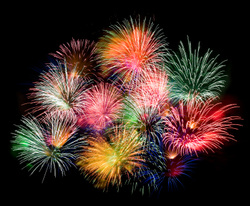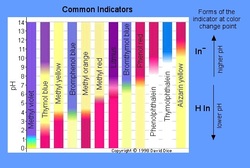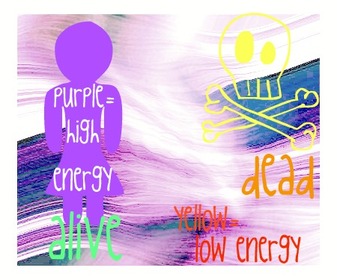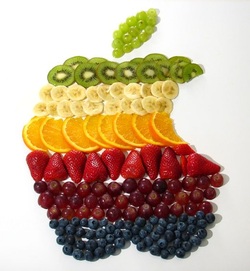Firework Chemistry

In this picture, and on this page, you can see that it's titled firework chemistry. Well, we named it this because,our main question/topic "why things have color" relates to chemistry in the way of fireworks. Many firework colors come from burning metal salts.
Color Compound:
Red: strontium salts, lithium salts
lithium carbonate, Li2CO3 = red
strontium carbonate, SrCO3 = bright red
Orange: calcium salts
calcium chloride, CaCl2
calcium sulfate, CaSO4·xH2O, where x = 0,2,3,5
Gold: incandescence of iron (with carbon), charcoal, or lampblack
Yellow: sodium compounds
sodium nitrate, NaNO3
cryolite, Na3AlF6
Electric White: white-hot metal, such as magnesium or aluminum
barium oxide, BaO
Green barium compounds + chlorine producer
barium chloride, BaCl+ = bright green
Blue: copper compounds + chlorine producer
copper acetoarsenite (Paris Green), Cu3As2O3Cu(C2H3O2)2 = blue
copper (I) chloride, CuCl = turquoise blue
Purple: mixture of strontium (red) and copper (blue) compounds
Silver: burning aluminum, titanium, or magnesium powder or flakes
Color Compound:
Red: strontium salts, lithium salts
lithium carbonate, Li2CO3 = red
strontium carbonate, SrCO3 = bright red
Orange: calcium salts
calcium chloride, CaCl2
calcium sulfate, CaSO4·xH2O, where x = 0,2,3,5
Gold: incandescence of iron (with carbon), charcoal, or lampblack
Yellow: sodium compounds
sodium nitrate, NaNO3
cryolite, Na3AlF6
Electric White: white-hot metal, such as magnesium or aluminum
barium oxide, BaO
Green barium compounds + chlorine producer
barium chloride, BaCl+ = bright green
Blue: copper compounds + chlorine producer
copper acetoarsenite (Paris Green), Cu3As2O3Cu(C2H3O2)2 = blue
copper (I) chloride, CuCl = turquoise blue
Purple: mixture of strontium (red) and copper (blue) compounds
Silver: burning aluminum, titanium, or magnesium powder or flakes
How do acids and bases connect to color?

Photo courtesy of veer marketplace.(:
When acids and bases combine they usually change to a different color. The only other way color relates to acids and bases is how litmus paper changes color when dealing with acids and bases. For more information look below.
Litmus Paper?

Photo courtesy of google images.(:
The most common way to figure out a pH of a solution, is to use an acid base indicator. Acid-Base indicators respond to a change in the hydrogen ion concentration. Most of the indicators are themselves, weak acids..
The most common indicator is found on "litmus" paper. It is red below pH 4.5 and blue above pH 8.2.
Color Blue Litmus Red Litmus
Acid turns red stays same
Base stays same turns blue
The most common indicator is found on "litmus" paper. It is red below pH 4.5 and blue above pH 8.2.
Color Blue Litmus Red Litmus
Acid turns red stays same
Base stays same turns blue
CHNOPS

Photo courtesy of, allposters.com (edited by. Amy Mason using Picnik.com)
CHNOPS stands for Carbon, Hydrogen, Nitrogen,Oxygen, Phosphorous, and Sulfur. These elements are what we need for living things such as animals to survive. When an animal becomes deceased, it slowly starts to decompose and lose energy. Therefore, it loses it's color.
Low Calorie Fruits
Low Calorie Vegetables
Nutrition:

Photo courtesy of livbit.com
Healthy foods..
Green- Naturally green foods are really good for you! They help most bodily functions, boost your energy, and eliminate toxins.
Red- Naturally Red foods are also pretty healthy. They contain lots of antioxidants which protect our bodies cells from damage. Another main nutrient in red foods is lycopene. Lycopene helps lower your risk in developing lung and stomach cancer.
These are the only colors that we found that relate to color but more vegetables and fruits are listed below that you can read and learn about.
